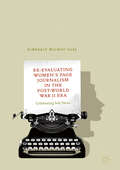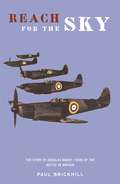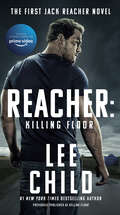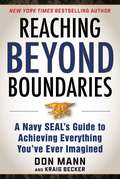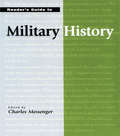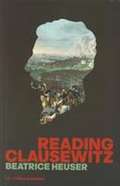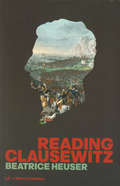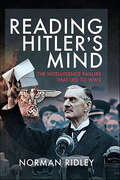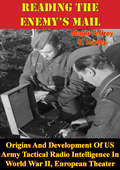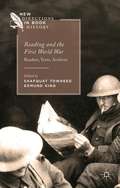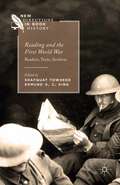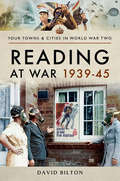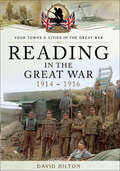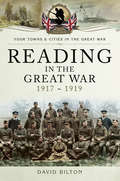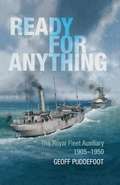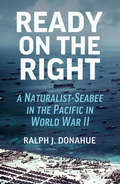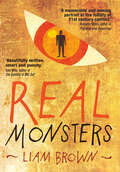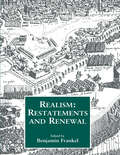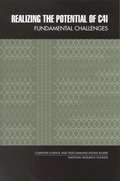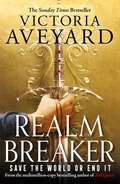- Table View
- List View
Re-Evaluating Women's Page Journalism in the Post-World War II Era: Celebrating Soft News
by Kimberly Wilmot VossRe-Evaluating Women’s Page Journalism in the Post-World War II Era tells the stories of significant women’s page journalists who contributed to the women’s liberation movement and the journalism community. Previous versions of journalism history had reduced the role these women played at their newspapers and in their communities—if they were mentioned at all. For decades, the only place for women in newspapers was the women’s pages. While often dismissed as fluff by management, these sections in fact documented social changes in communities. These women were smart, feisty and ahead of their times. They left a great legacy for today’s women journalists. This book brings these individual women together and allows for a broader understanding of women’s page journalism in the 1950s and 1960s. It details the significant roles they played in the post-World War II years, laying the foundation for a changing role for women.
Reach for the Sky
by Beverly SommersThere's nothing like the wide open spaces of the Midwest. Suzanne Allman's cross-country trip was fraught with accidents. First, daughter Mouse totaled a parked car just as they were crossing the Pennsylvania-Ohio border, which meant they were obliged to tote the cowboy on crutches, whose car, clothes and credit cards they'd destroyed, all the way to his Wyoming ranch. The second incident also involved Billy Blue, who chatted, joked and sang cowboy songs as they cruised through Ohio, Indiana and Illinois. With a man as unique as Billy at her side, it wasn't really an accident that Suzanne collided head-on with love. It seemed like one- but maybe accidents were just another name for destiny.
Reach for the Sky (W&N Military)
by Paul BrickhillThe bestselling story of Britain's most courageous and most famous flyer, the Second World War hero Sir Douglas Bader.In 1931, at the age of 21, Douglas Bader was the golden boy of the RAF. Excelling in everything he did he represented the Royal Air Force in aerobatics displays, played rugby for Harlequins, and was tipped to be the next England fly half. But one afternoon in December all his ambitions came to an abrupt end when he crashed his plane doing a particularly difficult and illegal aerobatic trick. His injuries were so bad that surgeons were forced to amputate both his legs to save his life. Douglas Bader did not fly again until the outbreak of the Second World War, when his undoubted skill in the air was enough to convince a desperate air force to give him his own squadron. The rest of his story is the stuff of legend. Flying Hurricanes in the Battle of Britain he led his squadron to kill after kill, keeping them all going with his unstoppable banter. Shot down in occupied France, his German captors had to confiscate his tin legs in order to stop him trying to escape. Bader faced it all, disability, leadership and capture, with the same charm, charisma and determination that was an inspiration to all around him.
Reach for the Sky: The Story Of Douglas Bader, Legless Ace Of The Battle Of Britain (CASSELL MILITARY PAPERBACKS)
by Paul BrickhillThe bestselling story of Britain's most courageous and most famous flyer, the Second World War hero Sir Douglas Bader.In 1931, at the age of 21, Douglas Bader was the golden boy of the RAF. Excelling in everything he did he represented the Royal Air Force in aerobatics displays, played rugby for Harlequins, and was tipped to be the next England fly half. But one afternoon in December all his ambitions came to an abrupt end when he crashed his plane doing a particularly difficult and illegal aerobatic trick. His injuries were so bad that surgeons were forced to amputate both his legs to save his life. Douglas Bader did not fly again until the outbreak of the Second World War, when his undoubted skill in the air was enough to convince a desperate air force to give him his own squadron. The rest of his story is the stuff of legend. Flying Hurricanes in the Battle of Britain he led his squadron to kill after kill, keeping them all going with his unstoppable banter. Shot down in occupied France, his German captors had to confiscate his tin legs in order to stop him trying to escape. Bader faced it all, disability, leadership and capture, with the same charm, charisma and determination that was an inspiration to all around him.
Reacher: Killing Floor (Jack Reacher #1)
by Lee ChildTHE FIRST NOVEL IN LEE CHILD'S #1 NEW YORK TIMES BESTSELLING JACK REACHER SERIES—NOW AN ORIGINAL SERIES ON PRIME VIDEO!&“From its jolting opening scene to its fiery final confrontation, Killing Floor is irresistible.&”—PeopleEx-military policeman Jack Reacher is a drifter. He&’s just passing through Margrave, Georgia, and in less than an hour, he&’s arrested for murder. Not much of a welcome. All Reacher knows is that he didn&’t kill anybody. At least not here. Not lately. But he doesn&’t stand a chance of convincing anyone. Not in Margrave, Georgia. Not a chance in hell.
Reaching Beyond Boundaries: A Navy SEAL's Guide to Achieving Everything You've Ever Imagined
by Don Mann Kraig BeckerFor the last decade, decorated Navy SEAL, accomplished athlete, and bestselling author Don Mann has been traveling across the country giving motivational talks and in the process inspiring hundreds with the secrets behind his awe-inspiring achievements. In Reaching beyond Boundaries, Mann brings his much sought-after wisdom to the page. As an elite Navy SEAL, Mann performed seemingly impossible tasks on a regular basis. Here he details the lessons he learned from his training and shows how the rest of us can apply those teachings to our daily lives in terms of learning to push beyond our internal boundaries and achieve the goals we’ve set for ourselves, both professionally and personally. Reaching Beyond Boundaries teaches how to set and conquer both micro- and macro-goals through removing excuses, having the right mindset, and learning from successes and failures. Making your dreams a reality is possible. With Reaching Beyond Boundaries you can begin to realize your fullest potential today.
Reader's Digest Soldier Stories
by Reader'S DigestReader's Digest Soldier Stories is a chronological retrospective of the best military pieces Reader's Digest has run, from World War I through the war in Iraq. Featuring stories from the battlefield to the home front, this inspiring collection honors the men and women of America’s armed forces and gives readers a glimpse into life in uniform.Beginning in World War I and continuing through to the war in Iraq, readers will follow soldiers into the trenches, peer in on emergency surgery taking place in the depths of the ocean, watch heroes carry the bodies of fallen brethren, trail Eisenhower for the three days leading up to D-Day, and be inspired as men and women rise above and beyond normal human limits to preserve our rights and save their friends. Other stories include those of: • A soldier’s last gift to her young daughter at home • A tribute to one of the first African-Americans to serve as a Naval Officer • A pilot rescued after his F-16 is shot down • A judge who sentenced a fellow veteran to jail, then joined him in his cell for the night to help him through his PTSD • An American soldier who takes a big risk to save a dying Afghan girl This book gives a complete perspective on the hell that is war, the love that grows from camaraderie, the pride from accomplishing the impossible, the humor that springs from the military bureaucracy, and more. A chronological retrospective of the best military pieces Reader's Digest has run, Reader’s Digest Soldier Stories honors the men and women of America’s armed forces.
Reader's Guide to Military History (Reader's Guiides Ser.)
by Charles MessengerThis book contains some 600 entries on a range of topics from ancient Chinese warfare to late 20th-century intervention operations. Designed for a wide variety of users, it encompasses general reviews of aspects of military organization and science, as well as specific wars and conflicts. The book examines naval and air warfare, as well as significant individuals, including commanders, theorists, and war leaders. Each entry includes a listing of additional publications on the topic, accompanied by an article discussing these publications with reference to their particular emphases, strengths, and limitations.
Reading Clausewitz
by Beatrice HeuserClausewitz's On War, first published in 1832, remains the classic study of the nature and conditions of warfare. Best remembered for his pronouncement that war is a continuation of politics by other means and for his observations on total war, he gave a new philosophical foundation to the art of war. Complex and often misunderstood, Clausewitz has fascinated and influenced generations of politicians and strategic thinkers.
Reading Clausewitz
by Beatrice HeuserClausewitz's On War, first published in 1832, remains the most famous study of the nature and conditions of warfare. Contemporaries found him 'endearing' or 'totally unpalatable', while later generations called him 'the father of modern strategical study', whose tenets have 'eternal relevance', or dismissed him as outdated. Was it really he who made the discovery that warfare is a continuation of politics? Was he the 'Mahdi of mass and mutual massacre', in part responsible for the mass slaughter of the First World War, as Liddell Hart contended? Can the idea of total war be traced back to him? Complex and often misunderstood, Clausewitz has fascinated and influenced generations of politicians and strategic thinkers. Beatrice Heuser's study is the first book, not only on how to read Clausewitz, but also on how others have read him - from the Prussian and German masters of warfare of the late nineteenth century through to the military commanders of the First World War, through Lenin and Mao Zedong to strategists in the nuclear age and of guerrilla warfare. The result is an accessible and comprehensive introduction to the work and influence of the greatest classic on the art of war.
Reading Hitler's Mind: The Intelligence Failure that led to WW2
by Norman RidleyMost strongly associated with Prime Minister Neville Chamberlain, it is often stated that Britain’s policy of appeasement was instituted in the 1930s in the hope of avoiding war with Hitler’s Nazi Germany. At the time, appeasement was viewed by many as a popular and seemingly pragmatic policy. In this book the author sets out to show how appeasement was not a naïve attempt to secure a lasting peace by resolving German grievances, but a means of buying time for rearmament. By the middle of the 1930s, British policy was based on the presumption that the balance of power had already dramatically shifted in Germany’s favour. It was felt that Britain, chiefly for economic reasons, was unable to restore the balance, and that extensive concessions to Germany would not satisfy Hitler, whose aggressive policies intensified the already high risk of war.. The only realistic option, and one that was clearly adopted by Neville Chamberlain, was to try to influence the timing of the inevitable military confrontation and, in the meantime, pursue a steady and economically sustainable program of rearmament. Appeasement would ‘buy’ that time for the British government. Crucially this strategy required continuously updated and accurate information about the strength, current and future, of the German armed forces, especially the Luftwaffe, and an understanding of their military strategy. Piercing the Nazis’ veil of secrecy was vital if the intelligence services were to build up a true picture of the extent of German rearmament and the purposes to which it might be put. The many agents, codebreakers, and counter-espionage personnel played a vital role in maximising the benefits that appeasement provided – even as war clouds continued to gather. These individuals were increasingly handed greater responsibility in a bid to inform British statesmen now scrambling to prepare for a catastrophic confrontation with Germany. In Reading Hitler’s Mind, Norman Ridley reveals the remarkable efforts made by the tiny, underfunded and often side-lined British intelligence services as they sought to inform those whose role it was to make decisions upon which the wheels of history turned.
Reading The Enemy’s Mail: Origins And Development Of US Army Tactical Radio Intelligence In World War II, European Theater
by Major Jeffrey S. HarleyThis thesis traces the development of American radio intelligence at the operational and tactical levels from its beginnings in World War I through the end of World War II. It shows that signals intelligence is useful to the tactical and operational level commander. The study recommends the Army rethink signal intelligence support to the various echelons, primarily through changes to tables of organization and equipment.The thesis covers the initial appearance of radio intelligence units on the battlefields of France in the first world war, identifying specific instances where radio intelligence played a role in a command decision. It also looks at training and doctrine in the period between the two world wars. The thesis also covers the organization, doctrine, and training of radio intelligence units as they prepared for combat. It provides a glimpse into the intelligence support provided to the corps, army, and army group commanders during World War II through examination of actual intercept operations. Where possible the study compares and contrasts German radio intelligence units and operations with their American counterparts.
Reading and the First World War: Readers, Texts, Archives (New Directions in Book History)
by Shafquat Towheed Edmund G. C. KingRanging from soldiers reading newspapers at the front to authors' responses to the war, this book sheds new light on the reading habits and preferences of men and women, combatants and civilians, during the First World War. This is the first study of the conflict from the perspective of readers.
Reading and the First World War: Readers, Texts, Archives (New Directions in Book History)
by Edmund King Shafquat TowheedRanging from soldiers reading newspapers at the front to authors' responses to the war, this book sheds new light on the reading habits and preferences of men and women, combatants and civilians, during the First World War. This is the first study of the conflict from the perspective of readers.
Reading at War, 1939–45 (Towns & Cities in World War Two)
by David BiltonA history of life in the southern English town during World War II.As in the Great War, Reading in the Second World War was a town permanently in a state of flux. So close to London, so easily pinpointed by its proximity to the Thames, with railway lines converging near the town center and with much of the town’s industry geared up to essential war work, it was an obvious target for the German Luftwaffe when the war broke out. Knowing this, the council had set up an efficient civil defense system aided by government finance. Fortunately for the citizens, although they were bombed on many occasions, only one raid had any significant impact.The book covers the daily life of a town ready for the worst, but one that continued with its daily life and just got on with its efforts to aid the war effort. The book is profusely illustrated with photographs, illustrations and human interest stories. Much of the material used has not been seen since the war so it provides a valuable and unique insight into daily life of the town.“David Bilton takes an in-depth look at how the people of Reading coped during the conflict. Interesting to read that suffering from German Air Raids was apparently minimal, and the photographs, as always, are fascinating to see. A brilliant series.” —Books Monthly (UK)
Reading in the Great War, 1914-1916 (Your Towns & Cities in the Great War)
by David BiltonHow the experience of war impacted on the town, from the initial enthusiasm for sorting out the German kaiser in time for Christmas 1914, to the gradual realization of the enormity of human sacrifice the families of Reading were committed to as the war stretched out over the next four years. A record of the growing disillusion of the people, their tragedies and hardships and a determination to see it through. Reading's experiences during the Great War can be taken as standing for the many smaller but important towns in the country whose story will never be told. However, being a county town it experienced both industrial and agrarian pressures that deeply affected its population. Initially enthusiastic about the war, recruitment soon dropped and the local regiment filled with men from the big cities. By 1916 most of the eligible men were keen to find ways to stay out of the army. In the centre of the town was the infamous Reading jail home to Irish dissidents, terrorists and POWs. On the surface it was a calm town that got on with its business: beer, biscuits, metalwork, seeds and armaments but its poverty impacted on industrial relations leading to strikes. It also had a darker side with child cruelty and death, especially suicide.
Reading in the Great War, 1917~1919 (Your Towns & Cities in the Great War)
by David BiltonReading in the Great War 1917–1919 looks at life in an important industrial and agricultural town in the south of England. The book charts the changes that occurred in ordinary people's lives, some caused by the war, some of their own doing.On the surface, Reading was a calm town that got on with its business: beer, biscuits, metalwork, seeds and armaments, but its poverty impacted on industrial relations leading to strikes. It was also a God-fearing, hard-working and sober town. However, underneath it had a darker side, all of it exposed in this book: drunkenness, desertion, suicide, child abuse, murder, double murder and underage sex; it was all there, happening when eyes were not watching.This is a book about human relationships: to each other and the outside world, warts and all. It is a telling account of the human tragedies and triumphs of a nation at war and the day-to-day preoccupations of community attempting to find normality in a reality so far removed from anything they had ever known. Including over 100 unique and rarely seen illustrations and expertly written by a prolific author, this is an enriching read for anybody wishing take a glimpse beneath the surface of life on Reading's Home Front.
Ready for Anything: The Royal Fleet Auxiliary, 1905–1950
by Geoff PuddefootSet up in August 1905, the Royal Fleet Auxiliary unofficial motto: Ready for Anything was originally a logistic support organisation, Admiralty-owned but run on civilian lines, comprising a miscellaneous and very unglamorous collection of colliers, store ships and harbour craft. This book charts its rise in fleet strength, capability and importance, through two world wars and a technical revolution, until the time when naval operations became simply impossible without it. Its earliest tasks were mainly freighting supplying the Royal Navys worldwide network of bases but in wartime fleets were required to spend much longer at sea and the RFA had to develop techniques of underway replenishment. This did not come to full fruition until the British Pacific Fleet operated alongside the Americans in 1944-45, but by then the RFA had already pioneered many of the procedures involved.This book combines a history of the service, including many little-known wartime operations, with data on the ships, and a portrait of life in the service gleaned from personal accounts and recollections. Half way between a civilian and a military service, the RFA has never received the attention it deserves, but this book throws a long-overdue spotlight on its achievements.
Ready on the Right: A Naturalist-Seabee in the Pacific in World War II
by Ralph James DonahueReady on the Right, first published in 1946, is a down-to-earth, firsthand account of an enlisted man's service in the Seabees in the Pacific in World War II. Author Ralph Donahue, who also served in Europe during the First World War, enlisted in the U.S. Navy, and was assigned to the 27th and 45th Naval Construction Battalions ‒ the Seabees. Donahue saw duty in the extremes of Alaska and the Aleutian Islands, to the tropical islands of the South Pacific (including Eniwetok, Guam, Ulithi, and Okinawa). In addition to his military duties, Donahue was an avid naturalist, exploring the areas in which he was deployed, and collecting specimens of insects, lizards, and plants; when possible he sent his collections to various museums in the States, where they were of lasting value to researchers. Included are Muster Lists for the Battalions and 14 pages of maps and photographs.
Ready, Set, Jett: Ready, Set, Jett / Gail's Gone Wild / Just One Taste (Men Of Honour Ser.)
by Lori FosterThis sexy alpha hero is about to meet his match in this beloved classic novella from New York Times bestselling author Lori Foster.In this reader-favorite novella from New York Times bestselling author Lori Foster, all middle school teacher Natalie Alexander needs to get her head—and heart—together is a vacation from her no-strings romance with her sexy next-door neighbor. But her solo trip south turns into a disaster when gorgeous PI Jett Sutter turns up with another challenge…one she might not be able to resist.Originally published in 2011.
Real Markets: Social and Political Issues of Food Policy Reform
by Cynthia Hewitt De AlcántaraFirst published in 1993. Routledge is an imprint of Taylor & Francis, an informa company.
Real Monsters
by Liam BrownAs a soldier&’s wife awaits information about his whereabouts overseas, he descends further into the madness of war in this &“memorable and moving&” novel (Benjamin Myers, author of Pig Iron). Reeling from the terrorist attack that killed her father, Lorna lurches through an inebriated adolescence until she finds love and redemption in a young soldier named Danny. But her dream of a stable life is once again shattered when Danny is called to serve overseas—and soon lost in the desert. Most of Danny&’s unit is dead. They are victims, it would seem, of a brutal ambush. With their equipment destroyed and food running out, the small band of men stumble through the sand and shadows, desperate to find salvation. As their hope fades, they begin to turn on each other. When it finally becomes clear that only the most vicious will survive, what will Danny be if he ever does return to Lorna?
Realism: Restatements and Renewal
by Benjamin FrankelRealism has been the subject of critical scrutiny for some time and this examination aims to identify and define its strengths and shortcomings, making a contribution to the study of international relations.
Realizing the Potential of C4I: Fundamental Challenges
by Committee to Review DOD C4I Plans ProgramsRapid progress in information and communications technologies is dramatically enhancing the strategic role of information, positioning effective exploitation of these technology advances as a critical success factor in military affairs. These technology advances are drivers and enablers for the "nervous system" of the military—its command, control, communications, computers, and intelligence (C4I) systems—to more effectively use the "muscle" side of the military.Authored by a committee of experts drawn equally from the military and commercial sectors, Realizing the Potential of C4I identifies three major areas as fundamental challenges to the full Department of Defense (DOD) exploitation of C4I technology—information systems security, interoperability, and various aspects of DOD process and culture. The book details principles by which to assess DOD efforts in these areas over the long term and provides specific, more immediately actionable recommendations. Although DOD is the focus of this book, the principles and issues presented are also relevant to interoperability, architecture, and security challenges faced by government as a whole and by large, complex public and private enterprises across the economy.
Realm Breaker: From the author of the multimillion copy bestselling Red Queen series (Realm Breaker)
by Victoria AveyardSAVE THE WORLD OR END IT ... A BRAND NEW SERIES from the multimillion-copy, #1 New York Times bestselling author of Red Queen, as seen on TikTok... A strange darkness is growing in the Ward. Even Corayne an-Amarat can feel it, tucked away in her small town at the edge of the sea.Fate knocks on her door, in the form of a mythical immortal and a lethal assassin, who tell Corayne that she is the last of an ancient lineage - with the power to save the world from destruction.Because a man who would burn kingdoms to the ground is raising an army unlike any seen before, bent on uprooting the foundations of the world. With poison in his heart and a stolen sword in his hand, he'll break the realm itself to claim it. And only Corayne can stop him.Alongside an unlikely group of reluctant allies, Corayne finds herself on a desperate journey to complete an impossible task, with untold magic singing in her blood and the fate of the world on her shoulders.Realm Breaker is the first book in an epic new series and an instant #1 New York Times Bestseller! Perfect for fans of THE CRUEL PRINCE, SIX OF CROWS and THE HUNGER GAMES - don't miss the next instalment in the series, Blade Breaker.PRAISE FOR VICTORIA AVEYARD'World building to rival the likes of George R.R. Martin' GUARDIAN'A fantasy fan's dream' Roseanne A. Brown, New York Times bestseller'A true fantasy masterpiece' Sabaa Tahir, #1 New York Times bestsellerREADERS LOVE THE REALM BREAKER SERIES'Victoria Aveyard is the queen of cliffhangers and shattering your emotions' - ⭐⭐⭐⭐⭐'This book has everything. Fantasy. Adventure. Betrayals. Assassins. Pirates. Magic. Quests. Aveyard is a master of building worlds.' - ⭐⭐⭐⭐⭐'This book will yank you out of a reading slump and rekindle your dormant high fantasy obsession. That's worth five stars in my book.' - ⭐⭐⭐⭐⭐
